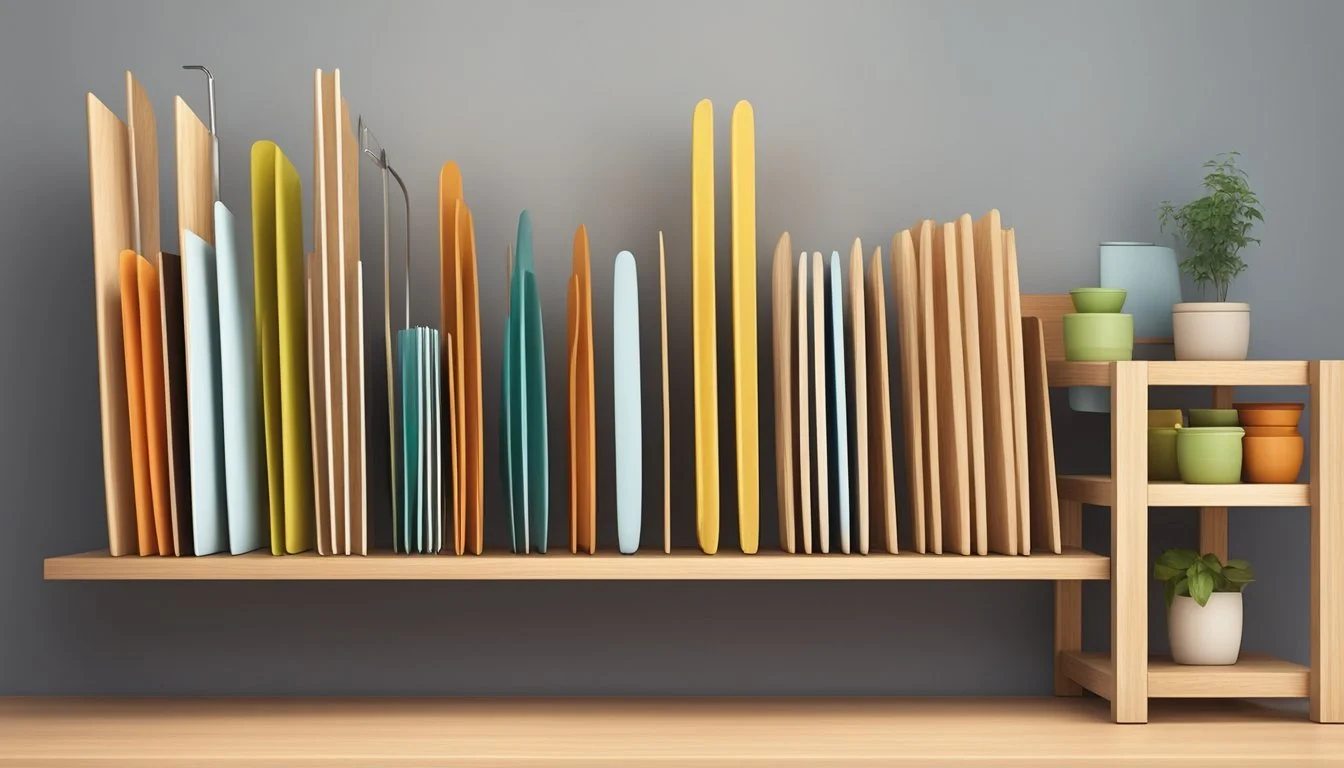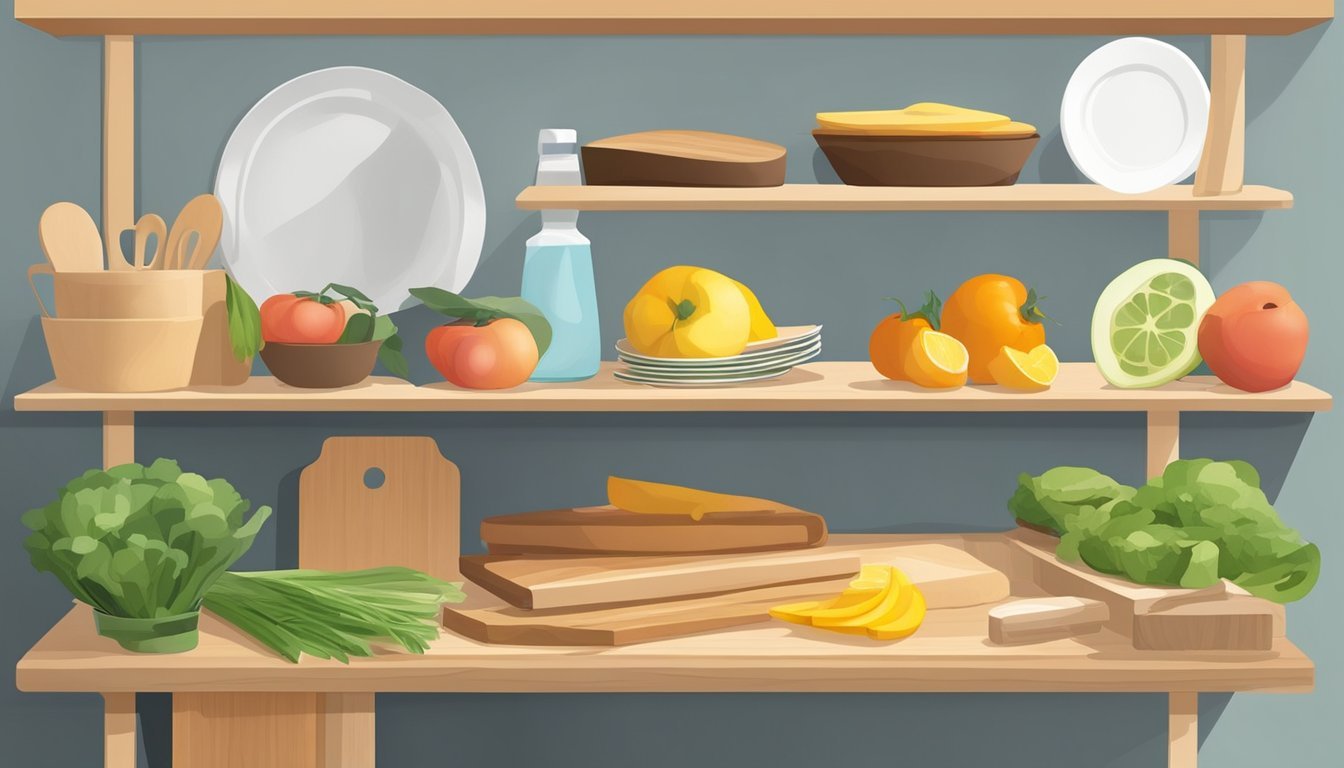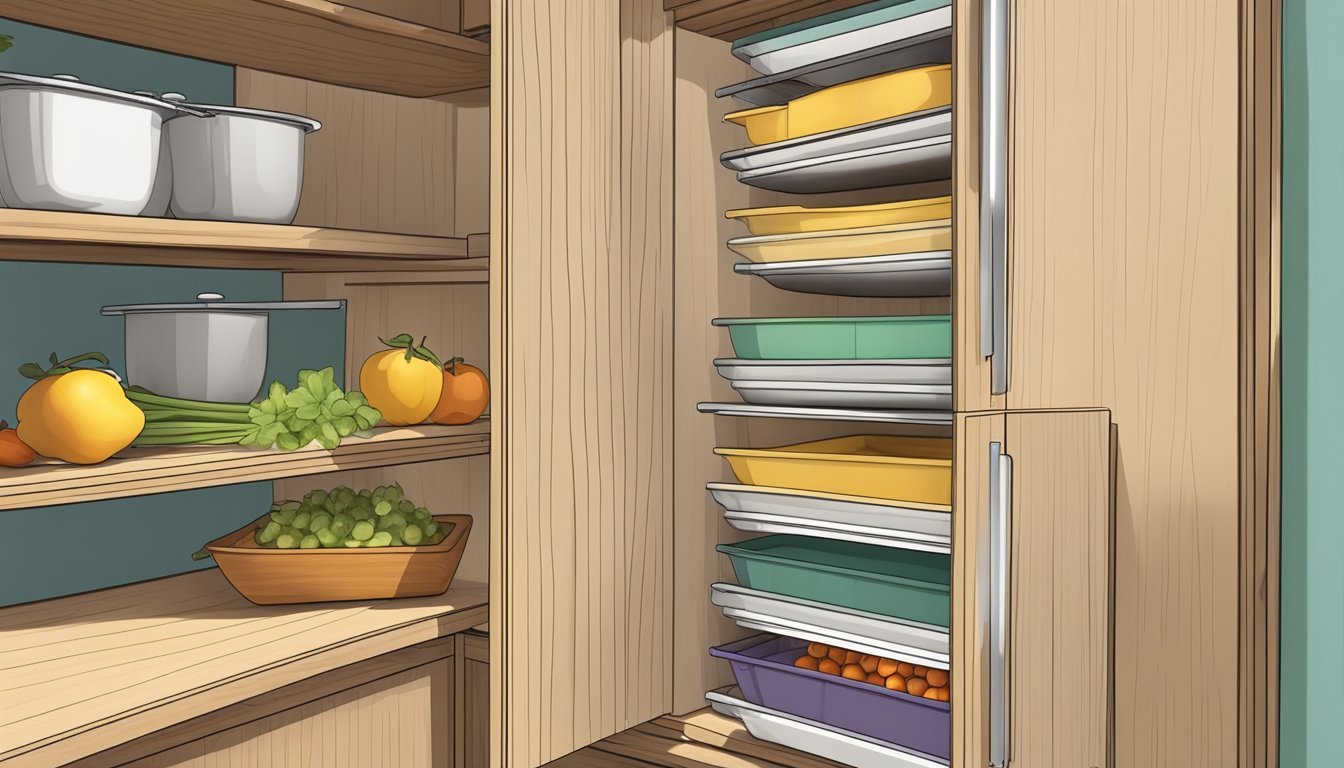The Best Way to Store Your Cutting Boards
Optimal Organization Tips
Storing cutting boards efficiently is as important as selecting the right one for your kitchen tasks. The best way to store cutting boards ensures both longevity and hygiene, keeping them easily accessible while avoiding cross-contamination. In a bustling kitchen, cutting boards are fundamental for a myriad of culinary preparations, from chopping vegetables to carving meats. Therefore, it is crucial that these vital tools are stored in a way that protects their surfaces from undue wear and prevents the growth of bacteria.
Effective storage solutions can range from hanging systems to vertical dividers, each designed to cater to kitchens of different sizes and the storage spaces available within them. A kitchen with limited space might benefit from a creative approach, such as using rails or hooks, to hang cutting boards on unused wall space or the sides of cabinets. Larger kitchens, on the other hand, might opt for dedicated drawers or shelves where boards can be neatly stashed away horizontally, but with ample space to prevent moisture accumulation.
Regardless of the method chosen, the aim is to maintain the cutting boards in an environment that promotes drying and avoids direct contact with other kitchen tools that could harbor bacteria. It is essential that after washing, cutting boards are thoroughly dried before storing to prevent warping and cracking. With proper storage solutions, cutting boards can remain a durable and hygienic part of kitchen equipment for food preparation.
Understanding the Materials
When it comes to cutting boards, the material dictates the care and storage required to maintain its durability and functionality. Different materials respond to environmental factors such as moisture and heat and need to be handled accordingly.
Wooden Cutting Boards
Wooden cutting boards are prized for their durability and classic appearance. They typically require more maintenance than their plastic counterparts. To preserve their condition, it's imperative to oil wooden cutting boards regularly with food-safe mineral oil or beeswax. This prevents the wood from drying out and cracking. Wood inherently contains moisture which can lead to warping if exposed to varying temperatures or if stored improperly. To prevent warping, one should store wooden cutting boards in an upright position to promote airflow and avoid moisture buildup.
Care Instructions:
Wash with mild soap and water
Dry thoroughly before storing
Oil periodically to maintain surface
Plastic Cutting Boards
Plastic cutting boards offer the benefit of durability and often come in various colors, aiding in preventing cross-contamination between different food types. They tend to be easier to clean, as most can be placed in the dishwasher. Unlike wood, plastic does not need oiling, but it should still be stored in a manner that allows it to remain dry and prevents the growth of bacteria.
Care Instructions:
Dishwasher safe (check manufacturer's guidelines)
Store in a dry location, avoiding stacking while damp
For both types of materials, correct storage is essential to extend the lifespan and maintain the safety of the cutting boards.
Choosing the Right Storage Solution
When selecting a storage method for cutting boards, one must consider space efficiency and ease of access. Each kitchen is unique in layout and size, impacting the storage solution chosen.
Space-Saving Techniques
In a tiny kitchen, using vertical space can be transformative. Installing magnetic strips inside cabinet doors or on a pantry wall can turn an unused surface into a convenient storage solution. Cutting boards adhere to the magnetic strip, freeing up valuable drawer and countertop space. Another vertical approach involves a rack mounted on a wall or hanging from the ceiling, which can hold multiple boards in a small footprint.
For those preferring cabinet storage, a wire organizer or a storage rack can be placed inside a cabinet to keep cutting boards upright and separated, ensuring they are neatly stowed away without taking up excessive space. Utilizing the back of cabinet doors with slim wire racks is also an efficient way to maximize the limited space.
Maintaining Accessibility
The objective is to store cutting boards in a way that makes them easy to retrieve and put away. For many, this means keeping them near the food preparation area for convenience. Vertical storage solutions not only save space but also make it easier to grab the desired board without having to unstack or sort through other kitchen tools.
Cabinet storage close to the countertop or prep area ensures cutting boards are at arm's reach when needed. To maintain organization and prevent boards from becoming buried, one might use dividers or a dedicated cutting board cabinet.
By carefully considering the layout of one's kitchen and the frequency of cutting board use, one can choose effective storage methods that balance both space-saving techniques and maintaining accessibility.
Innovative Storage Solutions
Storage solutions for cutting boards should maximize space efficiency and maintain accessibility. These solutions can transform cluttered kitchens into models of organization.
Vertical Storage Options
Vertical storage takes advantage of unused vertical spaces, which is especially beneficial in kitchens with limited counter space. Kitchen islands can serve as an ideal base for vertical storage with options such as:
Hanging Spaces: Homeowners can attach twine or kitchen-safe adhesives to cutting boards, making them ready to hang on hooks under a kitchen island or on a kitchen utensil rail.
Wall-Mounted Racks: Fixing a wall-mounted rack on an empty wall space or the side of a cabinet allows for cutting boards to be slid in and out with ease.
Drawer and Cabinet Organizers
In-drawer and cabinet solutions make use of concealed spaces, keeping cutting boards out of sight but within reach.
Pull-Out Drawers: A custom pull-out drawer can be installed with slots for standing cutting boards upright, making retrieval straightforward.
Built-In Options: For new cabinetry, consider a built-in cutting board drawer with dedicated slots.
Cutting Board Organizers: Utilize a cutting board rack within a cabinet to separate cutting boards and serving trays neatly.
Magnetic Solutions: Attaching magnetic strips to cupboard doors or inside panels offers a novel approach to store and easily access metallic or magnetized boards.
Protecting Your Cutting Boards
Proper storage techniques are crucial for maintaining a cutting board's durability and hygiene. These practices prevent cross-contamination and warping, ensuring that the cutting boards remain safe and functional for food preparation over time.
Preventing Cross-Contamination
One must store cutting boards in a manner that reduces the risk of cross-contamination. This involves:
Separate Storage: Assign specific cutting boards for different food types (meat, vegetables, and bread) and store them separately.
Clean Before Storing: Always clean cutting boards thoroughly with hot soapy water after use and before placing them in storage.
Caring for Cutting Boards
To care for cutting boards and extend their life:
Regular Cleaning: One should clean cutting boards with appropriate cleaning agents after each use to ensure hygiene.
Oiling: Periodically oiling wooden cutting boards maintains their condition and prevents drying and cracking.
Proper Drying: Ensure that cutting boards are completely dry before storage to prevent warping and the growth of bacteria.
Vertical Storage: Store cutting boards vertically to allow for airflow and prevent moisture retention that could lead to warping.
Creative Display and Decoration Ideas
When it comes to kitchen organization, displaying cutting boards should be both practical and aesthetically pleasing. A clever arrangement can enhance kitchen decor while keeping cutting boards within easy reach.
Aesthetic Arrangements
Basket Showcase: Utilize a stylish wire basket to house several cutting boards. Position it on the kitchen island or counter to add a rustic charm. This method allows cutting boards to be easily accessible and part of the kitchen's visual appeal.
Wall Art: Consider using hooks or a towel rod with clips to hang cutting boards on the wall. This not only saves space but also serves as a unique wall decoration. Arranging boards of various sizes and colors can create an engaging and functional art display.
Functional Decor
Countertop Elegance: Store cutting boards in an upright position using a plate rack or a wire organizer. This keeps them neat and tidy while showcasing the wood grain and craftsmanship like a library of culinary tools.
Island Integration: On a kitchen island, integrate a built-in slot or storage compartment specifically for cutting boards. This dedicated space ensures boards are easily accessible during meal prep and also kept out of sight when not in use, maintaining a clean and organized kitchen surface.
Tips for Organizing Multiple Cutting Boards
Organizing multiple cutting boards efficiently can save space and time in the kitchen. Here are some effective storage ideas:
Vertical Dividers: Use vertical dividers in a kitchen drawer or cabinet. This method allows cutting boards to be separated and stand upright for easy access and visibility.
Hanging Hooks: Install hooks on the inside of a cabinet door or on a kitchen wall. This keeps the cutting boards out of the way and can free up counter space.
Storage Type Pros Cons Vertical Dividers Easy to sort, space-efficient Requires drawer/cabinet space Hanging Hooks Maximizes vertical space, easily accessible Boards must have holes or handles
Knife Block with Slots: Some vertical knife blocks come with dedicated slots for cutting boards. This keeps both knives and boards organized in a single location.
Magnetic Strips: If the cutting boards are metal or have metal handles, magnetic strips can be a sleek way to store them against a wall or on the side of a refrigerator.
Racks or Stands: Utilize a freestanding rack or a wall-mounted version to hold the cutting boards. Ensure it's sturdy enough to hold the weight of multiple boards.
One should note that when using any of these storage solutions, there should be adequate airflow to prevent moisture buildup and that the cutting boards are stored in a clean and dry condition. This will help maintain their quality and hygiene.
Storing Cutting Boards in Small Spaces
In small kitchens, the key to storing cutting boards is to maximize vertical space and choose storage solutions that keep boards easily accessible yet out of the way.
Utilizing Wall Space
Magnetic Strips: Homeowners can attach magnetic strips to their kitchen walls, allowing cutting boards to adhere directly. This method is efficient and saves valuable counter space.
Pegboard System: Installing a pegboard gives one the flexibility to store cutting boards by hanging them on hooks. This customizable solution adapts to the different sizes and shapes of cutting boards.
Wall-Mounted Racks: Cutting board stands or racks that mount to the wall are an excellent way of utilizing vertical space. They often come with slots to accommodate multiple boards, keeping them sorted and within reach.
Maximizing Counter and Cabinet Space
Countertop Stand: For those who prefer cutting boards within arm's reach, a countertop stand with slots for various cutting boards can be a neat solution, occupying minimal counter space.
Cabinet Storage: A cabinet door organizer with racks can be installed to stow cutting boards, making use of the oft-ignored space on the inside of cabinet doors.
Vertical Dividers in Cabinets: Placing vertical dividers within a cabinet allows one to slide cutting boards into the divided sections, maintaining an organized look and preserving counter space.
Alternative Storage Ideas
Storing cutting boards efficiently maximizes space and keeps the kitchen organized. This section delves into innovative methods beyond traditional drawers and shelves.
Hanging and Magnetic Solutions
Hanging cutting boards can be a stylish and practical way to keep them within reach. One can use:
Twine or string: Attached through the board's handle for easy suspension.
Kitchen-safe adhesives: For boards without a hole, suitable adhesives can hold twine or hooks.
Hanging racks: Racks mounted to walls or ceilings present a secure method for arranging multiple boards.
Magnetic strips provide a sleek storage solution. They can be attached to the backs of boards, enabling them to adhere to any metallic surface in the kitchen. This arrangement promotes visibility and easy access.
Multipurpose Uses
Consider using cutting boards as multipurpose kitchen utensils. For example:
Silicone mats: These can serve as protective layers when stacking boards to prevent slipping and scratching.
Convertible racks: Some racks designed for plates or bakeware can be adapted to hold cutting boards, serving dual functions.
By embracing alternative storage ideas such as hanging solutions and magnetic mounts, as well as employing multipurpose storage approaches, one can store cutting boards in a way that is both functional and aesthetically pleasing.









